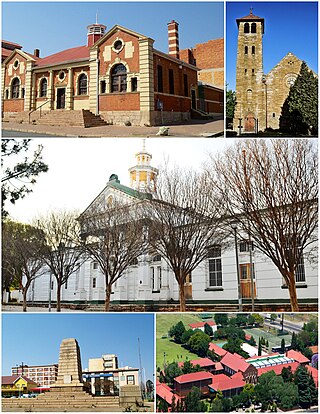
Earl of Lonsdale is a title that has been created twice in British history, firstly in the Peerage of Great Britain in 1784, and then in the Peerage of the United Kingdom in 1807, both times for members of the Lowther family.

Johannesburg is a large city in Gauteng Province of South Africa. It was established as a small village controlled by a Health Committee in 1886 with the discovery of an outcrop of a gold reef on the farm Langlaagte. The population of the city grew rapidly, becoming a municipality in 1898. In 1928 it became a city making Johannesburg the largest city in South Africa. In 2002 it joined ten other municipalities to form the City of Johannesburg Metropolitan Municipality. Today, it is a centre for learning and entertainment for all of South Africa. It is also the capital city of Gauteng.

The Witwatersrand Gold Rush was a gold rush that began in 1886 and led to the establishment of Johannesburg, South Africa. It was a part of the Mineral Revolution.

Boksburg is a city on the East Rand of Gauteng province of South Africa. Gold was discovered in Boksburg in 1887. Boksburg was named after the State Secretary of the South African Republic, W. Eduard Bok. The Main Reef Road linked Boksburg to all the other major mining towns on the Witwatersrand and the Angelo Hotel (1887) was used as a staging post.

Bedfordview is an affluent suburb in western Ekurhuleni, sharing an administrative boundary with the City of Johannesburg Metropolitan Municipality, Gauteng, South Africa. Bedfordview has been part of the City of Ekurhuleni Metropolitan Municipality since 2000. The Eastgate Shopping Centre, one of the biggest in Africa when first built, is also located here.
Doornfontein is an inner-city suburb of Johannesburg, South Africa, located to the east of the city centre, Region 8. In the 1930s, it attracted many Jewish immigrants, becoming the main hub for the city's Jewish community. Black African residents, then a minority in the suburb, lived in slum-yards. Under the Slums Clearance Act 1934, the slum-yards were cleared and many residents were relocated to Orlando, Soweto. Since the late 1970s, Doornfontein and other inner-city suburbs of Johannesburg have underdone high levels of white flight to the city's northern suburbs.
Randlords were the capitalists who controlled the diamond and gold mining industries in South Africa from the 1870s up to World War I.
East Rand Proprietary Mines (ERPM) is a 125-year-old underground gold mining operation on the Witwatersrand Basin at Boksburg, to the east of Johannesburg. The mine employed 3,850 people. It was the deepest mine in the world until 2008 at 3,585 metres depth, slightly more than the TauTona mine, also in South Africa, which was 3,581 metres at the time

Sir Lionel Phillips, 1st Baronet was a British-born South African financier, mining magnate and politician.
Anthony Edward Lowther, Viscount Lowther was an English courtier and soldier.
James Hugh William Lowther, 7th Earl of Lonsdale, was a British peer.
Willem Eduard Bok, also known as W. Eduard Bok was a Dutch-born South African Boer politician, civil servant and statesman, who served as first State Secretary of the South African Republic (Transvaal) from 1880 to 1889.

Captain John Percy Farrar, also known as Percy Farrar and as J. P. Farrar, was an English soldier and mountaineer. He was President of the Alpine Club from 1917 to 1919 and a member of the Mount Everest Committee. Farrar's obituary in The Times stated that he 'was known by repute to every one interested in mountaineering in England and on the Continent, and his personal friends at home and abroad were legion'.
The Minerals Council South Africa is a South African mining-industry employer organisation. Its members include famous South African mining houses such as Anglo American, De Beers, Gold Fields and Harmony. In its current form, it was founded in 1968 as the Chamber of Mines, a South African wide organization. Prior to that year, it has its early origins as the Transvaal Chamber of Mines in 1887, then evolved over many years reforming as the Witwatersrand Chamber of Mines in 1889, the Chamber of Mines of the South African Republic from 1897, Transvaal Chamber of Mines from 1902 and lastly from 1953 until 1967 as the Transvaal and Orange Free State Chamber of Mines. On 23 May 2018, the South African Chamber of Mines rebranded themselves as the Minerals Council South Africa.

Hoërskool Voortrekker is a public Afrikaans medium co-educational high school situated in the municipality of Boksburg in the city of Ekurhuleni in the Gauteng province of South Africa. The academic school was established in 1920.

John Howard was an English industrialist, an inventor of agricultural equipment and four times the Mayor of Bedford.
Hans Sauer was an Orange Free State born medical doctor, lawyer, adventurer and businessman. He is regarded as a Rand Pioneer, arriving in Johannesburg in 1886 shortly after the discovery of gold and was the town's first district surgeon. He is linked with the creation of Rhodesia.
Ernest Willmot Sloper was an architect active in Johannesburg, South Africa and in the United Kingdom. He designed Bishopskop for Michael Furse, bishop of Pretoria. He also designed his own house in Parktown, Endstead
Katherine Lowther born Katherine Thynne became Katherine, Viscountess Lonsdale was an English electoral patron. After her husband's death, she took over with his political influence in north-west England.
The Tambo Memorial Hospital is a regional hospital located in Boksburg (Ekurhuleni) in Gauteng Province, South Africa.









